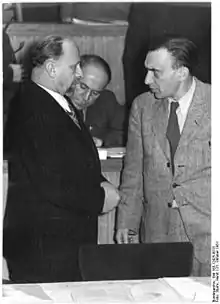Rudolf Herrnstadt
Rudolf Herrnstadt (18 March 1903 – 28 August 1966) was a German journalist and communist politician – most notable for his anti-fascist activity as an exile from the Nazi German regime in the Soviet Union during the war and as a journalist in East Germany until his death, where he and Wilhelm Zaisser represented the anti-Ulbricht wing of the Socialist Unity Party (SED) in the 1950s.
Rudolf Herrnstadt | |
|---|---|
.jpg.webp) Herrnstadt – a 1952 sketch | |
| Born | 18 March 1903 |
| Died | 28 August 1966 (aged 63) |
| Occupation | journalist |
Herrnstadt actively provided intelligence about Nazi Germany and Poland to the Soviet Union in the 1930s.
Biography
Herrnstadt was born in the Upper Silesian city of Gleiwitz (now Gliwice, Poland), where his father was employed as a lawyer. He began studying law in Heidelberg in 1922, but moved towards writing instead, becoming a journalist for the left-wing Berliner Tageblatt in 1929. He began working for the newspaper in 1925 as a typesetter. He joined the Communist Party of Germany (KPD) in 1929, fleeing the country in 1933, when the arrival of Adolf Hitler at the seat of power made Herrnstadt a target, both as an unrepentant communist activist and as a Jew.
Abroad
Herrnstadt came to work for Soviet intelligence in the 1930s and spent most of the decade in Warsaw. With the invasion of Poland by the Nazi military in 1939, Herrnstadt fled to the Soviet Union and came to reside in Moscow, where he applied and was accepted into the Communist Party of the Soviet Union.[1] Despite criticism from some members of the German exile community for his "anti-revolutionary" views, Herrnstadt was among the members of the National Committee for a Free Germany. He returned to Germany as a member of the Sobottka Group, which laid the groundwork for the Soviet Military Administration in Germany in Mecklenburg.[2]
Against Walter Ulbricht

After the death of Joseph Stalin in 1953 Walther Ulbricht was summoned for a visit to Moscow with the new Soviet leadership, where he was criticized for his introduction of collective farms and a slower course towards socialist construction. Herrnstadt was among the domestic critics of Ulbricht's line of the SED as a leading politician with candidate member status in the SED's Politburo and chief editor of the Neues Deutschland; a key ally during this time was Wilhelm Zaisser, who criticized Ulbricht from his position as the country's Minister of State Security and a leading party ideologist. However, Herrnstadt's dissension against the course of the Ulbricht faction was also criticized by Soviet adviser Vladimir Semyonov, who answered Herrnstadt's attack by replying that "in two weeks you may no longer have a state."[3]
Ulbricht-led East Germany had pursued a course of reform since March 1953. After the 1953 East German Uprising Herrnstadt was removed from his position in the SED's Politbüro the same year. He was also removed from the Neues Deutschland at around the same time at the Ulbricht's request, according to the autobiography of fellow communist Markus Wolf.[4]
Herrnstadt died on 28 August 1966.
References
- Grieder, Peter. The East German Leadership, 1946-73: Conflict and Crisis. ISBN 0-7190-5498-2, ISBN 978-0-7190-5498-3. Manchester: Manchester University Press, 1999. P. 54.
- "Namensliste der drei KPD-Einsatzgruppen vom 27. April 1945" Archived 2014-12-15 at the Wayback Machine German Federal Archives. BArch NY 4036/517. Retrieved November 22, 2011 (in German)
- Maier, Charles S. Dissolution: The Crisis of Communism and the End of East Germany. Princeton, New Jersey: Princeton University Press, 1999. ISBN 0-691-00746-2, ISBN 978-0-691-00746-5. P. 17.
In 14 Tagen werden Sie vielleicht schon keinen Staat mehr haben." - Wolf, Markus & Anne McElvoy. The Man Without a Face: The Autobiography of Communism's Greatest Spymaster. ISBN 1-891620-12-6, ISBN 978-1-891620-12-6. New York: PublicAffairs, 1999. P. 69.